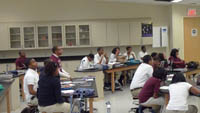Renaissance snares Detroit championships
Detroit’s Renaissance High School opened its new location in 2005, an airy, light-filled building designed to house the district’s brightest and most ambitious students. Applicants must pass a test to be admitted and maintain a 2.5 grade-point average, and be admitted to a college or university to graduate. Standards are high at Renaissance, and are reflected in its victories in the two high-school categories of Bridge Magazine’s Academic City Championships for Detroit.
Renaissance graduates 96.96 percent of its students, with 11 percent of juniors in the 2010-11 school year reaching proficiency on all sections of the ACT college exam. (Statewide, the averages are a 76 percent graduation rate and 17 percent of tested students deemed college ready under ACT standards.)
Renaissance isn’t the only Detroit high school with a high graduation rate. Cass Technical, Crockett Technical, Communication & Media Arts and Detroit School of Arts all had grad rates above 90 percent.
Principal Anita Williams says Renaissance encourages high achievement across the board, among all students, with a liberal-arts, college-prep curriculum of rigorous courses and few electives. (That’s in contrast to larger, better-known Cass Tech, which requires students to choose an academic major.)
In the fall student census, 1,175 students were enrolled at Renaissance, 98 percent of them African American, typical for the overwhelmingly black city. Williams said 40 percent qualify for free or reduced-price lunch, the standard measure of significant economic disadvantage used in education statistics. For the 2010-11 school year, Bridge's database found that 43 percent of Ren High students were eligible for free lunch; 50 percent of the students were eligible for free or reduced-price lunches.
However, the school provides free lunch to all students as a matter of policy, so Williams, who works as a server in the cafeteria most days, doesn’t necessarily know who they are.
Selecting the champs |
| To crown "Academic City Champions," Bridge Magazine used the following techniques:For rankings in 8th grade math, science and reading and 4th grade math, reading and writing, Bridge compared the percentage of students scoring at or above proficiency standards on the Michigan Educational Assessment Program (MEAP) from the 2010-11 school year.For college readiness rankings, Bridge compared the percentage of juniors earning proficient scores in the four academic categories of the ACT in 2010-11 school year; students needed to earn proficient scores in English, math, science and reading to be considered college-ready.For graduation rankings, Bridge compared the four-year graduation rates (the percent of freshmen who graduate in four years) for 2010, the most recent year available. |
“Those (economically disadvantaged) students have caring parents,” she said. “There’s a family feel to the culture here,” she said.
Much of that comes in individual meetings and counseling, where students are encouraged to aim high.
“They’ll come in here and say, ‘I’m going for a 33 on my ACT,’” said Williams. “Most won’t get it, but they’re going for it.”
The school has a number of special programs for students, including a Junior ROTC chapter, which may be taken with no obligation for military service. Many students walk the hall in full uniforms, and take separate classes as part of enlistment. Williams said she recommends it to parents who want their children to develop habits of discipline.
Another program, called Bridge (no connection to this magazine), begins the summer before freshman year, and offers support to those who need it. Bridge also gives educators a head start in identifying students gifted enough to be candidates for Advanced Placement courses – offered in all core subject areas – later in their high-school careers.
Williams, in her first year at Renaissance, is adding an ACT prep course to the curriculum, “not to teach to the test, but to teach the form of the test,” she explained. It will help students in one of her long-term goals – raising scores on the key college-prep diagnostic.
Reading success at Ludington
Ludington Magnet Middle School claimed top honors in the city for 8th Grade Reading proficiency, with 89.5 percent of its eighth-graders scoring proficient on the state test (vs. a statewide average of 82 percent).
"As a school of choice, Ludington is committed to elevating student achievement to recognized national standards," said Principal Alora Comer-Maxwell. "Our teachers come early and stay late to work with students and help them out. The testimony to that is (from) high school students who say they've received a great foundation to get to the next level."
Ludington Magnet is open to students throughout DPS and requires an application for admission, although there is no entrance test or grade requirement for entrance.
Comer-Maxwell noted that the school accepts students at every achievement level.
Nancy Nall Derringer has been a writer, editor and teacher in Metro Detroit for seven years, and was a co-founder and editor of GrossePointeToday.com, an early experiment in hyperlocal journalism. Before that, she worked for 20 years in Fort Wayne, Indiana, where she won numerous state and national awards for her work as a columnist for The News-Sentinel.
Michigan Education Watch
Michigan Education Watch is made possible by generous financial support from:
Subscribe to Michigan Education Watch
See what new members are saying about why they donated to Bridge Michigan:
- “In order for this information to be accurate and unbiased it must be underwritten by its readers, not by special interests.” - Larry S.
- “Not many other media sources report on the topics Bridge does.” - Susan B.
- “Your journalism is outstanding and rare these days.” - Mark S.
If you want to ensure the future of nonpartisan, nonprofit Michigan journalism, please become a member today. You, too, will be asked why you donated and maybe we'll feature your quote next time!




